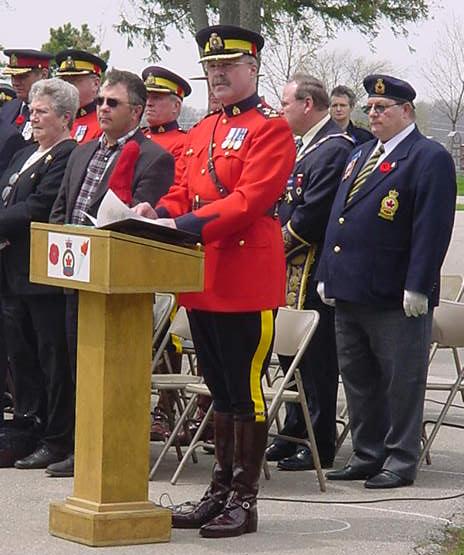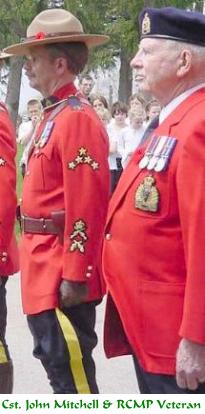
Address
of
RCMP Assistant Commissioner
Bradley C. Holman
Commanding Officer "O" Division
(Ontario)

Good afternoon, my name is Assistant Commissioner
Bradley Holman, Commanding Officer of the RCMP in Ontario.
We are here today to join with the community of Stratford in
re-dedicating the gravesite of Staff Sergeant Samuel Hopkins
Horner, a distinguished Canadian and member of the RCMP family.
 It was through a passion for
RCMP history that a member of our Kitchener Detachment, Constable
John Mitchell, discovered two years ago that the gravesite of
Samuel Hopkins Horner was not included in our list of police
graves for the area.
It was through a passion for
RCMP history that a member of our Kitchener Detachment, Constable
John Mitchell, discovered two years ago that the gravesite of
Samuel Hopkins Horner was not included in our list of police
graves for the area.
John engaged the assistance of local researcher Stephen Budge as well as Lutzen Riedstra from the Stratford-Perth Archives to begin tracing the Horner family history. With this information, along with documents from RCMP archives in Ottawa, a story began to emerge of an esteemed gentleman, a decorated soldier, and one of our first Mounties.
Consequently, a rededication was in order and one that would pay tribute to the important contributions made by Staff Sergeant Samuel Hopkins Horner to the RCMP, this community and to Canada. Additionally, and equally important, one that would bring him home to our police family.
As a result, we are here today to re-dedicate the grave-site of Samuel Hopkins Horner and to unveil an RCMP Bronze Marker located at the base of the resting place of Samuel and his sister.
Today's ceremony will be, in part, a re-enactment of the original 1929 funeral and will include participation from various groups that reflect their roles on that occasion. I will identify those groups in a few moments, but first I would like to acknowledge some distinguished members of the community who are joining us today:
Special Assistant Lee Gudgeon, representing Member of Parliament Gary Schellenberger;
Mr. Jack Horan, representing Member of Provincial Parliament John Wilkinson;
Mayor of Stratford Dan Matheson;
Stratford Police Service Chief Jerry McEwin;
Superintendent Dale Begbie, RCMP District Commander;
Staff Sergeant Don Miller, Detachment Commander, RCMP Kitchener;
Deputy Grand Master, Right Worshipful Brother Gary Atkinson of the Grand Lodge of Ancient Free and Accepted Masons of Canada in the Province of Ontario;
Royal Canadian Legion President Jim Millar;
Special Guests Ethel and James Tattersall. James Tattersall is a retired Sergeant with the RCMP and great great-Nephew of Samuel Hopkins Horner. They have flown here from British Columbia to be with us today.
Special Guests Lillian and Arthur Eglinton. The Eglintons lived with Samuel and his sister Selina here on Birmingham Street just after the First World War. They still live in Stratford.
Special Guest Mr. Samuel Dunseith. Mr. Dunseith lived across the street from Samuel Hopkins Horner here in Stratford. He now lives in Wallaceburg.
Welcome distinguished guests.
I would like to now recognize the groups participating in today's ceremony and those who are here to replicate their participation in the 1929 funeral as Honour Guards or Honourary Pall Bearers:
|
The Royal Canadian Regiment, the current Canadian military unit stationed in the London-Stratford area. Samuel Hopkins Horner was one of the founders of its predecessor, the Stratford Rifle Company. The Royal Canadian Regiment appears today in their scarlet uniforms as part of the Honour Guard, reflecting Horner's early military service to his country; |
|
Legion Veterans from World War II and the Korean War, reflecting Samuel Hopkins Horner's war record. He was twice decorated for "valuable services rendered" in the Fenian Raid of 1866 and the Northwest Rebellion of 1885; |
|
RCMP members and veterans; |
|
Members of Stratford Lodge #332 and Tecumseh Lodge #144. Samuel Hopkins Horner was a life member of the Stratford Masonic Lodge #332 and a member of the Anglican church. The members of both lodges were Pall Bearers for Horner's casket in 1929 and appeared in full regalia to honour their brother; |
|
The Perth County Pipe Band, made up of military veterans, police and private citizens; and |
|
the Anne Hathaway School Choir from Stratford. |
These groups represent the local communities that Samuel Hopkins Horner called home before his death.
Samuel Hopkins Horner was born on October 19th, 1845 in Schenectady, New York, the eldest son of Samuel Horner, a well-known educator and lecturer in astronomy and his wife Elizabeth Walker. He had four brothers and five sisters.
The Horner family moved to Canada in 1847, settling in the Welland area before moving to Stratford in 1867. Samuel was educated in Hamilton and St. Catharines and mastered the trade of saddlery, a craft encouraged by his father who was an advocate of technical education along with academic learning.
Samuel's military service began at the age of seventeen when he joined the Canadian Volunteers in 1861 when war threatened between Great Britain and the United States over the Trent Affair.
He then served in the Fenian Raids of 1866 and the Red River Expedition of 1870. Staff Sergeant Horner also served in the Northwest Rebellion of 1885 and was present at the treaty signing with the Cree Indians in 1876 and with the Blackfoot and Stoney Nations in 1877.
 Staff Sergeant Horner lived here in
Stratford, Ontario from 1867 until 1875 when he joined the
North-West Mounted Police as the Saddler Major, a key figure of
the time in keeping police horses equipped for patrol, and who
oversaw the repair and maintenance of all saddlery.
Staff Sergeant Horner lived here in
Stratford, Ontario from 1867 until 1875 when he joined the
North-West Mounted Police as the Saddler Major, a key figure of
the time in keeping police horses equipped for patrol, and who
oversaw the repair and maintenance of all saddlery.
For years, police had difficulties obtaining suitable harness, head collars, bridles and other saddlery accessories. The answer was to do the job "in-house" and the man for the job was Samuel Hopkins Horner.
Horner held the rank of Staff Sergeant from 1875 to 1890. He was easily recognizable around the barracks in Regina by his huge, unkempt black beard and often with his black horse named "Tomahawk".
He was a shy and modest man who made many friends in civilian as well as military circles. One of his friends was the legendary Sam Steele.
Staff Sergeant Horner's Regimental Number was #6. When you consider that the current Regimental Numbers of the RCMP are over 50,000, you can see that Samuel Hopkins Horner was indeed one of the first 'pioneers of policing' in Canada and holds a significant place in RCMP history.
In 1890, Staff Sergeant Horner retired from the North West Mounted Police and moved to Lethbridge, Alberta to start a saddle and harness business.
He continued to provide equipment to the Force and was also hired as a "Special Constable" from 1896 to 1898, spending some of that time in the Yukon.
According to his obituary, "eventually the lure of the Mounted Police urged him to re-engage" and he returned to Regina in 1904, proving that the adage "Once a Mountie, always a Mountie" was true even in the early 1900's.
Samuel Hopkins Horner remained with the Royal North West Mounted Police until 1907 when he returned to Stratford and married Annie Yemen.
 However, his second
retirement was only temporary. During World War I, at the age of
sixty-nine, he was called back to duty to inspect artillery,
saddlery and harness manufactured in Canada for the governments
of Britain, France and Russia.
However, his second
retirement was only temporary. During World War I, at the age of
sixty-nine, he was called back to duty to inspect artillery,
saddlery and harness manufactured in Canada for the governments
of Britain, France and Russia.
Following the war, Mr. Horner returned to Stratford, and after the death of his wife, he took up residence at 281 Birmingham Street with his sister Selina, a well-known teacher in the area.
Samuel Hopkins Horner died on April 10th, 1929 at the age of eight-three, two days after the sudden death of Selina. Samuel had been ailing for some time and was unable to withstand the loss of his sister.

By his direction, both Samuel and Selina were buried side by side here in Avondale Cemetery under one headstone.
The deaths of Selina and Samuel Horner were felt
by the
entire community. The Stratford Beacon Herald of
April 10th, 1929 stated "by personal friends,
former colleagues and his superior officers,
Samuel Hopkins Horner was beloved and respected
as a gallant soldier and a gentleman."
Today, we are honoured to join with the community of Stratford in paying tribute to this distinguished Canadian and a member of the RCMP family.
I would like to thank each and every one of you for attending this important ceremony.
In particular, I want to thank the relatives and friends of Staff Sergeant Horner for coming forward with their stories and their memories. We started out two years ago looking for one man. We ended up discovering a whole family, an entire community and a treasured ‘missing link' in RCMP legacy and Canadian history.
Thank you.